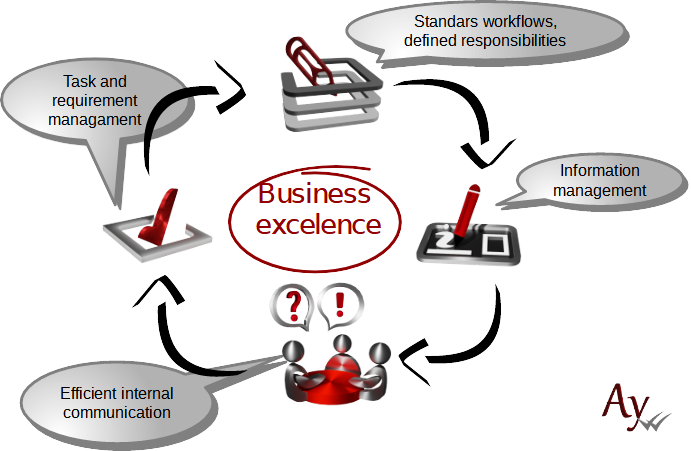How can the functioning of a company or organisation be improved? The first step is to analyse how the company works internally.
Process analysis is the first place to start when we want the company works better.

We can help with efficiency
- We find the problem
- We have tools to improve efficiency of communication, task management and controlling responsibilities
We analyse how your company is performing in each area and we can identify the good and bad points. We use our own experience and internationally recognised techniques to assess whether processes, collaboration, information handling and other key activities are working effectively or whether it makes sense to invest in improving them.
If the aim of the assessment is also to obtain an official statement, e.g. for the parent company or clients, external standards,we conduct audits in full compliance with external standards.
Process audit
A high-quality process audit is the basis for well-prepared changes and progress of a team. Our analysts can quickly identify which processes are working well and where improvements are needed. They can effectively assess both the degree of optimization of routine activities and compliance with external standards. On the other hand, however, the audit will also find a unreasonable effort to define everything precisely, where bound by process procedures prevents development.
Process audit is not a formal procedure
Many companies (and non-profit organizations, since they have a process audit linked to the conditions for granting subsidies) perceive the audit as a necessity for external bodies, whether it is to comply with regulatory measures, the aforementioned subsidies or other reasons “ordered” from the outside.
A well-conducted process analysis is an important step for internal improvement. It will result in:
- a map describing the flow of activities,
- a description of cooperation and contact points within the company and with cooperating teams and companies,
- a description of information flows,
- quality check points and further breakdown of the process sequence
- a number of other descriptions that go to different depths depending on what is important to deal with.
On this basis, it is possible to analyse how much time and other resources each activity, cooperation and communication actually costs, where mistakes are made and where unnecessary delays.
Of course, the output of the process analysis is an important basis for further internal optimization even after the audit is completed..
Audit of IT technology according to ITIL
IT technologies are now an essential part of every company, but not every company knows how to use them in a way that they can really bring the benefits they can. Another common problem is the management's inability to effectively assess which IT costs are efficient and the waste of resources on investments that do not have a return.
By analysing IT performance and its benefits to other areas of work, we can assess whether the potential of ICT is being used effectively or whether there is room for further improvement. We can also advise on other forms of IT management or a change of approach to how the whole IT is used. We use the COBIT methodology for this. .
Assessment of cooperation methods
One of the most common causes of errors, delays and avoidable costs is slow and inefficient collaboration.
A particular part of the assessment focuses exactly on how teams work together, how they share information and know-how, and how it can be improved. The Collaboration Assessment is a useful tool for small teams and large companies, especially those with sites in different locations or using shared competences centers.
Audit of services
Deficiencies in service delivery are often the cause of low productivity and profitability of a company. Often, the problem is not primarily the quality of service delivery, but the way in which services are defined and provided internally and whether the company is able to meet its promises or commitments.
A service audit will check the company is internally optimally set up in terms of resources, processes and procedures. We use the CMMI-SVC methodology for this.
We can also audit whether the contract set-up meets the needs of customers.
Decision-making efficiency
The discrepancy between competencies and responsibilities is a frequent reason why decision-making, approvals and changes in a company are slow, poorly prepared. Typical consequences are that tasks remain unfinished and deadlines have to be “chased”. Traditionally, decision-making is an area mostly attributed exclusively to management, but this is a simplistic view (although often reflected in practice). It is the audit that will show whether, for example, decision-making power is unhealthily concentrated in the hands of a senior manager who, although making decisions, does not have sufficient knowledge of the issues or has to get to the bottom of the problem, which costs a lot of time.
Decision-making is crucial for company flexibility
A decision-oriented audit checks whether who decides what is in line with the capabilities of those involved (knowledge, time, ability to enforce the decision, ability to assess its seriousness, etc.) . Inappropriate decision-making powers can lead to poor decisions, but often lead to a significant slowdown in the company's work and to low flexibility because decisions are pending even though knowledgeable staff have all the necessary information.
The assessment often includes checking that the “decision matrix” complies with the standards and laws that the firm must follow
We can help you fine-tune management structures in particular, but also the delegation of responsibility to the right people. The company's responsiveness to change will increase, everyone will enjoy the work more and a frequent cause of stress will be eliminated.
Project Management
A very common source of problems is how the organisation manages internal projects and how consistency between projects and day-to-day operations is ensured. The analysis assesses how the prioritisation, collaboration between projects and operational or ongoing activities is carried out and what opportunities management has to monitor and correct the progress of projects.